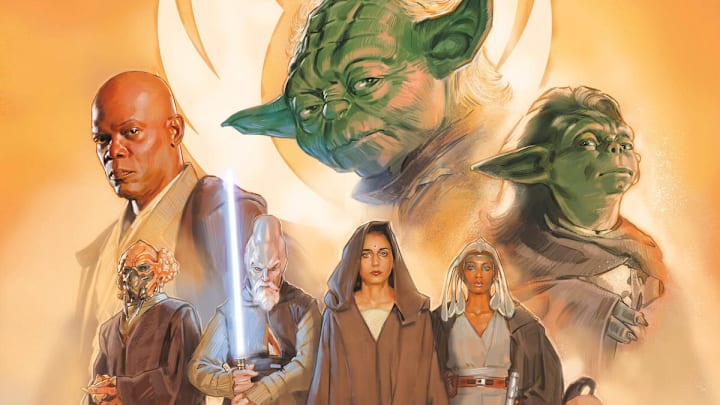This article contains spoilers from Star Wars: The Living Force by John Jackson Miller.
I long ago lost count of how many times I've watched The Phantom Menace, and yet, as I watched it in theaters for the 25th anniversary re-release, I saw it with a new perspective that made the movie even better. This is partly due to the novel The Living Force by John Jackson Miller, released in the month leading up to The Phantom Menace's re-release.
Taking place a year before The Phantom Menace, The Living Force sees Qui-Gon Jinn hearing firsthand from Republic citizens about how they have lost faith in the Jedi, with their visible outreach throughout the galaxy gradually dwindling. This leads Qui-Gon to challenge the Jedi Council to help at least one person in need, not from the Jedi Council Chamber or in a private meeting with Republic politicians, but to go out into the galaxy and make a tangible difference.
The Living Force's setup enriches the dynamic between Qui-Gon and the Jedi Council in The Phantom Menace. In both stories, the Council listens to Qui-Gon, but many of their members are skeptical of what he has to say. In Miller's novel, there is skepticism about Qui-Gon's challenge as they are already devoting their lives to helping others and cannot see how they have lost touch with everyday people. In The Phantom Menace, there is skepticism about Qui-Gon saying he encountered a Sith Lord on Tatooine and that the nine-year-old boy he discovered there, Anakin Skywalker, is the prophesied Chosen One.
Despite the Council's skepticism, they not only hear Qui-Gon out but ponder what he has to say and actively respond to it. In The Living Force, Qui-Gon's challenge takes all twelve members of the Jedi Council to the planet Kwenn, and they end up helping the people of Kwenn more than they could have ever anticipated. A year later, they test Anakin to ascertain if he is the Chosen One. Despite their doubts and Ki-Adi-Mundi's assertion that "the Sith have been extinct for a millennium," Mace Windu encourages Qui-Gon and his Padawan Obi-Wan to "unravel the mystery of the Sith" when they go back to Naboo with Queen Amidala.
It's easy to blame the fall of the Jedi Order on the Jedi Council members, who are mostly seen in The Phantom Menace in the Jedi Council Chamber, almost seeming detached from current struggles. By making each Jedi Council member a point of view character in The Living Force, Miller gives each of these Jedi Masters a distinct personality, along with their own outlooks on the Force and what it means to be a Jedi, not to mention their own personal struggles.
They all care about being a Jedi and helping others, but the crushing weight of Republic bureaucracy and countless other factors have taken their toll and made it difficult to be the Jedi they always wanted to be. There is also Palpatine, who is not a major character in The Living Force. Still, he has a couple of scenes that show his machinations already at work and compromising the Jedi into the position that will lead to their destruction. This further heightens the overtly sinister nature of his appearances as Darth Sidious and the more subtle evil at play as Senator (and later Chancellor) Palpatine in The Phantom Menace.
During the Jedi Council scenes in The Phantom Menace, my attention was held by every single member, not just the ones who speak (Yoda, Mace Windu, and Ki-Adi-Mundi). With Yarael Poof poking fun at the ever-serious Ki-Adi-Mundi in The Living Force, I wonder what he is thinking when Ki-Adi-Mundi talks about the Sith being extinct for a millennium. With Even Piell connecting to and inspiring young people in The Living Force, I wonder what he makes of young Anakin. Never before have the Jedi Council scenes been quite so compelling for me, making me want to spend more time there with each of these characters who The Living Force brought to life like never before.
In addition to the Jedi Council, The Living Force also adds more layers to the importance of Jar Jar Binks and his relationship with Qui-Gon in The Phantom Menace. The Living Force introduces three pirates called Lobber, Ghor, and Wungo. Their blatant incompetence is a source of comic relief and makes others, such as Obi-Wan, dismissive of them. But as Qui-Gon and Obi-Wan continue to run into them and let them go throughout the story, Qui-Gon becomes convinced that this has happened for a reason and uses his unlikely connection to these pirates as an opportunity that proves crucial to defeating Zilastra, The Living Force's primary antagonist.
Jar Jar is far more intelligent, competent, and well-intentioned than the Lobber, Ghor, and Wungo, but the same basic parallels apply to The Phantom Menace. Beyond the comic relief Jar Jar provides, Qui-Gon fosters a connection with Jar Jar and sees value in him, while others, including Qui-Gon's own Jedi Padawan, overlook and underestimate the Gungan, who is ultimately integral to liberating Naboo from the Trade Federation's invasion.
The Phantom Menace has always been a good Star Wars movie, but The Living Force makes it even more special during its 25th anniversary. Star Wars books are great on their own, but they're also wonderful in the ways that they can enhance the movies, even decades later, after countless viewings.
